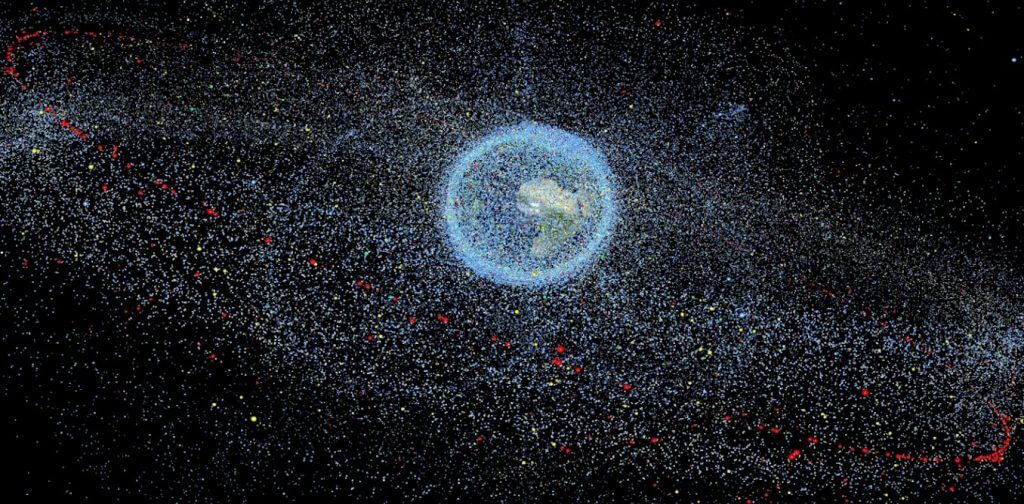
Harpoons, robots and lasers: How to capture defunct satellites and other space junk and bring it back to Earth (Image Credit: Phys.org)
More than half of the thousands of satellites in orbit are now defunct, and this accumulation of floating space debris has been described as a “fatal problem” for current and future space missions and human space travel.
An estimated 130 million objects smaller than 1cm and 34,000 larger than 10cm are traveling in orbit at speeds of thousands of kilometers per hour, according to the European Space Agency (ESA). A report presented at this year’s European conference on space debris suggests the amount of space junk could increase fifty-fold by 2100.
While many fragments of space junk are small, they travel so fast their impact has enough energy to disable a satellite or cause significant damage to space stations.
Both the Hubble Telescope and the Solar Maximum Mission (SMM) satellites had coin-sized holes punched into them by flying debris and a mirror on Nasa’s James Webb space telescope was damaged by micrometeoroids.
Most satellites were not designed with the end of their usefulness in mind. About 60% of the 6,000 satellites in orbit are now out of order. Along with the smaller objects these defunct satellites constitute a major problem both for existing and future satellites and space stations.
Mega constellations of satellites currently being sent into space by corporations such as SpaceX and Amazon are expected to transform access to the internet for all countries. But these private telecommunications ventures will also contribute 50,000 more satellites to already dangerously populated orbits.
Scientists have warned the rapid development of mega constellations risks several “tragedies of the commons,” including to ground-based astronomy, Earth’s orbit and Earth’s upper atmosphere.
Methods to remove space debris
There is a growing concern, described as the Kessler Syndrome, that we may be creating an envelope of space debris which could prevent human space travel, space exploration and the use of satellites in some parts of Earth’s orbit. This scenario, perpetuated by collisions between space objects creating ever more debris, could also damage our global communications and navigation systems.
This is why the development of practical debris removal technologies is important and urgent. So far, various strategies have been conceptualized to solve the space debris problem and some have been recently prioritized.
To date, not a single orbiting object has been recovered from space successfully.
One of the main problems in designing space debris removal strategies is how to transfer the energy between the debris (target) and the chaser during the first contact. There are two prioritized approaches and a third in development:
- Impact energy dissipation methods seek to decrease the impact energy of the debris. In one approach, the chaser satellite deploys a harpoon to penetrate the space debris. After the successful shot, the chaser satellite, harpoon and target would become connected by an elastic tether and the chaser would pull the debris to re-enter the atmosphere and burn up together.
- Neutral energy balance includes a magnetic capture method which uses magnetic coils to achieve perfect energy balance between chaser and target. This is a soft docking method which is a preliminary step to some subsequent method of debris disposal.
- Destructive energy absorption aims to destroy small debris targets using a high-powered laser. But the challenge is to develop a laser and battery combination that is powerful but lightweight enough. A laboratory in China has been developing a space-based laser system to be installed on a chaser satellite capable of targeting debris of up to 20cm in size. The Nasa Orion project uses ground-based lasers to destroy small debris.
The first space removal project is scheduled for 2025 and will be led by the ESA. It involves a consortium approach based on a Swiss spinoff company, ClearSpace.
The ClearSpace chaser will rendezvous with the target and capture it using four robotic arms. The chaser and captured launcher will then be de-orbited and burn up in the atmosphere.
High cost and more pollution
A key challenge is the substantial cost associated with these proposed solutions, given the immense scale of the space debris problem. Another important aspect is the potential impact of space-clearing efforts on our planet’s atmosphere.
The idea that a growing number of satellites and other objects would be incinerated in the atmosphere as they are removed from space concerns climate scientists. Space debris is pulled downward naturally and burns up in the lower atmosphere, but increasing levels of carbon dioxide are reducing the density of the upper atmosphere, which could diminish its capacity to pull debris back towards Earth.
The combustion of more and more satellites and other space debris (80 tons per year at present) falling either naturally or via the new removal methods will also release decomposition products into the atmosphere.
These will certainly contribute more carbon dioxide and other greenhouse gases. The decomposition of certain materials in satellites is also likely to release chlorofluorocarbon (CFC) gases, which could damage the ozone shield.
One cannot miss the parallels between the space junk problem and waste recycling. Clearly, we need to devise a circular economy strategy for our space waste.
At present the legal responsibility for space debris lies with the country of origin. This seems to militate against future international cooperative programs of space junk removal.
Explore further
This article is republished from The Conversation under a Creative Commons license. Read the original article.
Harpoons, robots and lasers: How to capture defunct satellites and other space junk and bring it back to Earth (2022, September 13)
retrieved 14 September 2022
from https://phys.org/news/2022-09-harpoons-robots-lasers-capture-defunct.html
part may be reproduced without the written permission. The content is provided for information purposes only.





